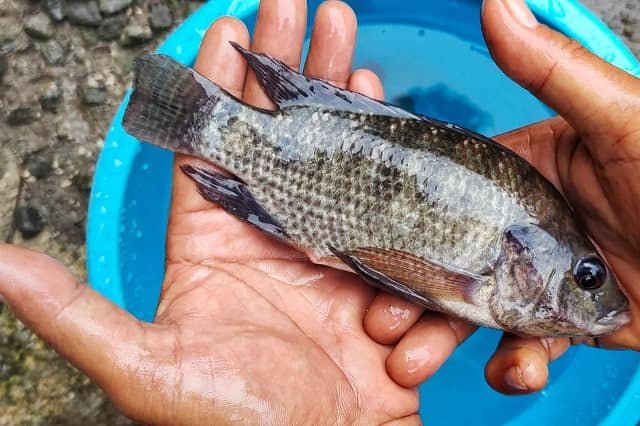
by Earlham Institute
Candidate genes that could help fish to tolerate warmer and saltier water have been identified in new research from the Earlham Institute, potentially providing a vital resource to guide breeding programmes in freshwater aquaculture.
As water quality and availability is reduced by higher global temperatures, these insights can be used to breed more resilient fish and safeguard a key source of food for millions of people.
The Nile tilapia, Oreochromis niloticus, is widely farmed in freshwater aquaculture, providing essential nutrients and protein. Their use in aquaculture has risen dramatically, largely due to their adaptability to different water conditions and production systems.
Soaring global temperatures, however, have depleted freshwater resources. Fish farms – and the people who rely on them for food – urgently need strains that can still thrive despite the higher salinity and increased water temperature.
To address this issue, researchers at the Earlham Institute, University of Stirling, and the University of East Anglia have explored the tilapia genome to locate advantageous changes in the genome responsible for an increased tolerance to changing water conditions.
They examined tissue taken from the gills – an important osmoregulatory organ in fish – and generated DNA and RNA sequence data to study the activity, regulation, and function of different genes.
They then identified genetic differences at gene regulatory regions in the Nile tilapia and 27 other tilapia species.
Their assumption was that differences between the Nile tilapia, a freshwater species, and species adapted to saline waters are likely to have arisen to control genes involved with adapting to different water environments.
Stay Always Informed
Join our communities to instantly receive the most important news, reports, and analysis from the aquaculture industry.
The team optimised a genome sequencing approach that reveals the activity of potential transcription factor binding sites and genetic switches for turning expression on and off.
Their approach identified regions of the genome they believe are responsible for controlling the activity of certain osmoregulatory genes, which in turn influence the function of the gills and how the fish responds to changing water conditions.
They identified a number of genes relevant to traits that help tilapia to tolerate saltier water and also acclimatise to freshwater. These included genes involved in metabolism and general housekeeping processes responsible for reacting to environmental changes in order to maintain balance.
Dr Tarang Mehta, study author and postdoctoral research scientist at the Earlham Institute, said: “Breeders are in desperate need of genomic resources to inform their breeding programmes so traits offering greater resilience can be quickly and accurately selected for.
“By characterising the genes responsible for these desirable traits, we can now share these new resources with freshwater fish farms to help guide selective breeding programmes.”
Dr Wilfried Haerty, study author and Group Leader at the Earlham Institute, said: “We identified regions of the Nile tilapia genome we can target to help breed fish with higher tolerance to salt – something that has sadly become increasingly important as our freshwater resources are degraded.
“The next steps are to use similar genomic approaches to find genes and their regulators associated with other traits of interest for aquaculture, like growth and disease resistance”
The input of the Genomics Pipelines Group at the Earlham Institute was critical in the data generation, including preparation of RNA-Seq libraries, pooling, and sequencing.
The research was funded by the Biotechnology and Biological Sciences Research Council (BBSRC), part of UK Research and Innovation.
Reference (open access)
Tarang K. Mehta, Angela Man, Adam Ciezarek, Keith Ranson, David Penman, Federica Di-Palma, Wilfried Haerty. 2023. Chromatin accessibility in gill tissue identifies candidate genes and loci associated with aquaculture relevant traits in tilapia. Genomics, Volume 115, Issue 4, 2023, 110633, ISSN 0888-7543,
https://doi.org/10.1016/j.ygeno.2023.110633.
Editor at the digital magazine AquaHoy. He holds a degree in Aquaculture Biology from the National University of Santa (UNS) and a Master’s degree in Science and Innovation Management from the Polytechnic University of Valencia, with postgraduate diplomas in Business Innovation and Innovation Management. He possesses extensive experience in the aquaculture and fisheries sector, having led the Fisheries Innovation Unit of the National Program for Innovation in Fisheries and Aquaculture (PNIPA). He has served as a senior consultant in technology watch, an innovation project formulator and advisor, and a lecturer at UNS. He is a member of the Peruvian College of Biologists and was recognized by the World Aquaculture Society (WAS) in 2016 for his contribution to aquaculture.




